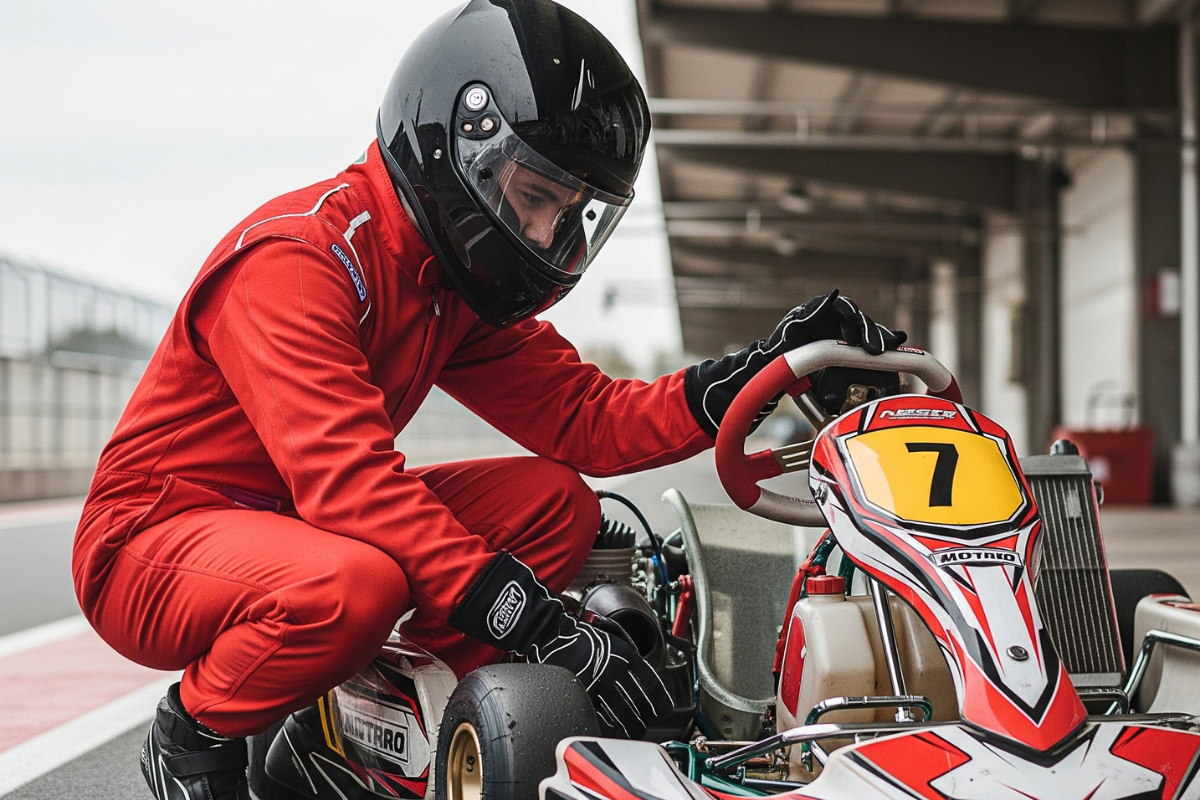Go-karting is an exhilarating and accessible motorsport that offers a fantastic blend of speed, skill, and competitive fun. Whether you’re a weekend enthusiast enjoying a session with friends or an aspiring racer honing your skills, safety should always be your top priority. The thrill of karting should never overshadow the importance of taking the necessary precautions to protect yourself and others on the track. This comprehensive guide will walk you through essential karting safety tips, covering everything from choosing the right helmet and protective gear to conducting crucial pre-race checks. By following these guidelines, you can maximize your enjoyment of karting while minimizing the risks involved.
Gearing Up for Safety: Essential Protective Equipment
The first and most crucial step towards a safe karting experience is equipping yourself with the right protective gear. This isn’t just about complying with track rules; it’s about providing a vital barrier against potential injuries.
1. The Unbreakable Rule: Always Wear a Certified Helmet
Your head is the most vulnerable part of your body during a karting session. A high-quality, certified helmet is non-negotiable.
- Certification Matters: Look for helmets that meet or exceed safety standards set by organizations like Snell (SA2020 or newer), FIA 8859-2015, or ECE 22.05. These certifications ensure the helmet has undergone rigorous testing.
- Proper Fit is Key: A helmet that’s too loose or too tight won’t offer adequate protection. It should fit snugly around your head without causing pressure points. Your cheeks should be slightly compressed, and the helmet shouldn’t move excessively when you shake your head.
- Full-Face Protection: Opt for a full-face helmet whenever possible, as it provides comprehensive protection for your head, face, and chin. Ensure the visor is clear and offers a wide field of vision.
2. Suit Up for Safety: The Importance of a Racing Suit
A karting racing suit is more than just attire; it’s a layer of defense against abrasions and even fire.
- Abrasion Resistance: In the event of a fall or slide, the suit protects your skin from road rash caused by contact with the track surface.
- Impact Protection: Many suits have padding in key areas like shoulders, elbows, and knees to cushion against impacts.
- Fire Resistance: For more competitive karting, fire-resistant suits (often with FIA homologation) offer critical protection in case of a fire.
- Proper Fit: Choose a suit that fits well, allowing a full range of motion without being baggy.
3. Protecting Your Core: Don’t Forget the Rib Protector
Your ribs and internal organs are particularly vulnerable in a kart due to the rigid seat and the forces experienced during cornering. A rib protector is essential.
- Impact Distribution: It’s designed to absorb and distribute the forces of impacts, preventing painful bruising or even fractures.
- Snug Fit: Ensure your rib protector fits snugly around your torso without restricting breathing.
4. Hand in Glove: The Role of Karting Gloves
Karting gloves provide grip, prevent blisters, and offer impact protection for your hands.
- Enhanced Grip: They provide better control over the steering wheel, especially during long sessions.
- Blister Prevention: They protect your hands from rubbing against the steering wheel.
- Impact Protection: Many gloves have padding on the knuckles and palms.
- Good Fit: Choose gloves that fit well and allow for good dexterity.
5. Footwear Matters: Opt for Karting Shoes
Karting-specific shoes are designed for optimal pedal feel and protection.
- Thin Soles for Pedal Feel: They allow for precise control over the throttle and brake pedals.
- Ankle Support: Many karting shoes offer ankle support and protection.
- Narrow Profile: Their design helps prevent your feet from getting caught on the pedals or chassis.
- Fire Resistance: Some karting shoes also offer fire resistance.
6. Neck Support: Consider a Neck Brace or Collar
A neck brace or neck collar helps to limit neck movement during an impact, reducing the risk of whiplash or more serious neck injuries.
- Neck Brace: Offers more comprehensive protection by limiting a wider range of head and neck motion. Often mandated in higher levels of competition.
- Neck Collar: Provides basic support and cushioning. A good starting point for recreational karting.
Before You Hit the Track: Essential Pre-Race Checks
Beyond personal protective equipment, ensuring the kart itself is in good working order is crucial for safety. Whether you own your kart or are renting one, performing pre-race checks can help identify potential issues before they lead to an accident.
1. Tire Check: Pressure and Condition
- Tire Pressure: Ensure tires are inflated to the recommended pressure. Over-inflated or under-inflated tires can affect handling and grip.
- Tire Condition: Check for any signs of damage, such as cuts, bulges, or excessive wear. Uneven wear can also indicate alignment issues.
2. Brake System Inspection: Responsiveness and Function
- Brake Lever/Pedal Feel: Check that the brake lever or pedal feels firm and responsive. Spongy or loose brakes indicate a potential problem.
- Brake Functionality: Ensure the brakes engage smoothly and effectively when applied. Listen for any unusual noises.
- Brake Lines and Fluid: If you own your kart, inspect brake lines for leaks and ensure adequate brake fluid levels.
3. Steering System Check: Smoothness and Play
- Steering Wheel Movement: Check for excessive play or looseness in the steering. The steering should feel direct and responsive.
- Steering Components: Visually inspect the steering column, tie rods, and other components for any signs of damage or wear.
4. Chain and Sprocket Examination (If Applicable)
- Chain Tension: Ensure the chain has the correct tension. A loose chain can come off, and an overly tight chain can cause wear.
- Chain Lubrication: The chain should be properly lubricated for smooth operation.
- Sprocket Condition: Check the sprockets for worn or damaged teeth.
5. Throttle and Pedal Operation: Smooth and Unobstructed
- Throttle Response: The throttle should return smoothly to the closed position when released. Check for any sticking or binding.
- Pedal Clearance: Ensure the throttle and brake pedals move freely and are not obstructed by anything.
6. Seat and Harness Adjustment: Secure and Comfortable
- Seat Position: Adjust the seat to a comfortable position that allows you to reach the pedals and steering wheel easily.
- Harness Security: Ensure the safety harness (if equipped) is properly adjusted and securely fastened. It should be snug but not overly tight.
7. Fuel and Fluid Levels (If Applicable)
- Fuel Level: Ensure there is an adequate amount of fuel for your session.
- Oil Level: If you own a four-stroke kart, check the oil level.
8. Visual Inspection for Loose or Damaged Parts
- Bodywork: Check for any loose or damaged body panels that could come off during driving.
- Fasteners: Ensure all nuts, bolts, and screws appear to be properly tightened.
If You’re Renting a Kart: While the track staff usually performs basic maintenance, don’t hesitate to do a quick visual inspection yourself and report any concerns to the staff before you go on the track. Your safety is paramount.
On-Track Awareness and Safe Driving Practices
Once you’re on the track with the right gear and a seemingly sound kart, your behavior and awareness are crucial for continued safety.
1. Pay Attention to Flag Signals
Understanding and obeying karting flag signals is non-negotiable. They communicate vital information about track conditions and race status. (Refer to a dedicated guide on karting flags for a detailed explanation.)
2. Drive Within Your Limits
Don’t push beyond your skill level or the capabilities of the kart. Gradually build your speed and familiarize yourself with the track. Overconfidence can lead to mistakes and accidents.
3. Maintain a Safe Following Distance
Avoid driving too closely to the kart in front of you. Allow yourself enough time to react to sudden braking or unexpected maneuvers.
4. Smooth and Predictable Driving
Drive smoothly and predictably. Avoid sudden changes in direction or speed that could surprise other drivers.
5. Respect Other Drivers
Be mindful of other karters on the track. Avoid aggressive or reckless driving. Give others space and be courteous.
6. No Intentional Contact
Karting is a non-contact sport. Deliberately bumping or colliding with other karts is dangerous and can lead to injuries and penalties.
7. Be Aware of Track Conditions
Pay attention to the track surface. Look out for oil spills, debris, or wet patches that could affect grip.
8. Know the Track Rules
Familiarize yourself with the specific rules and regulations of the karting facility you are visiting.
9. Heed Marshal Instructions
Track marshals are there for your safety. Always follow their instructions promptly and without question.
10. If You Spin Out or Stop on Track
If you lose control and spin out or your kart stops on the track, try to steer it to a safe area away from the racing line as quickly as possible. If you cannot move it safely, stay in your kart with your seatbelt fastened and raise your hand to signal for assistance.
Prioritizing Safety for Maximum Fun
Go-karting is an incredibly enjoyable and rewarding activity. By prioritizing safety and following these essential tips, you can significantly reduce the risks involved and ensure a positive experience every time you hit the track. From wearing the right protective gear to conducting thorough pre-race checks and practicing safe driving habits, every step you take towards safety contributes to a more enjoyable and sustainable involvement in the sport. So, gear up, check your kart, stay aware, and most importantly, have fun safely!

Ramon Splinter is a passionate go-kart enthusiast and expert who shares valuable tips and insights on Zyorb, a blog dedicated to karting enthusiasts. With years of experience on the track, he specializes in helping beginners and seasoned drivers improve their skills, optimize their karts, and master racing strategies. His articles combine technical knowledge with practical advice, making go-karting more accessible and exciting for all.

